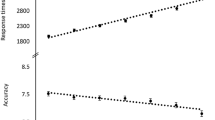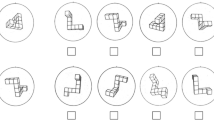Abstract
The ability to mentally rotate objects in space has been singled out by cognitive scientists as a central metric of spatial reasoning (see Jansen, Schmelter, Quaiser-Pohl, Neuburger, & Heil, 2013; Shepard & Metzler, 1971 for example). However, this is a particularly undeveloped area of current mathematics curricula, especially in North America. In this article we discuss what we mean by mental rotation, why it is important, and how it can be developed with young children in classrooms. We feature results from one team of teacher-researchers in Canada engaged in Lesson Study to develop enhanced theoretical understandings as well as practical applications in a geometry program that incorporates 2D and 3D mental rotations. Children in the Lesson Study classrooms (ages 4–8 years) demonstrated large gains in their mental rotation skills during 4 months of Lesson Study intervention in the Math for Young Children research program. The results of this study suggest that young children from a wide range of ability levels can engage in, and benefit from, classroom-based mental rotation activities. The study contributes to bridging a gap between cognitive science and mathematics education literature.








Similar content being viewed by others
References
Bauer, B., & Jolicoeur, P. (1996). Stimulus dimensionality effects in mental rotation. Journal of Experimental Psychology: Human Performance and Perception, 22(1), 82–94.
Bruce, C. & Flynn, T. (2012). Integrating instruction and play in a Kindergarten to Grade 2 lesson study project. In L.R. Van Zoest, J.J. Lo, & J.L. Kratky, (Eds.), Proceedings of the 34th annual meeting of the North American Chapter of the International Group for the Psychology of Mathematics Education. Kalamazoo: Western Michigan University.
Bruce, C., Flynn, T. & Moss, J. (2013). A “no-ceiling” approach to young children’s mathematics: preliminary results of an innovative professional learning program. In Proceedings of the 35th annual meeting of the North American Chapter of the International Group for the Psychology of Mathematics Education. Chicago: University of Chicago.
Bruce, C., Flynn, T., Ross, J., & Moss, J. (2011). Promoting teacher and student mathematics learning through lesson study: a design research approach. In B. Ubuz (Ed.), Proceedings of the thirty-fifth conference of the International Group for the Psychology of Mathematics Education (Vol. 2, pp. 193–200). Ankara: PME.
Bruce, C., & Ladky, M. (2011). What’s going on backstage? Revealing the work of lesson study. In L. Hart, A. Alston, & A. Murata (Eds.), Lesson-study research and practice in mathematics education: learning together (pp. 243–249). New York: Springer.
Bruce, C., Moss, J., & Flynn, T. (2012). Report on year 1 of the Math for Young Children Lesson Study research project. Toronto: Literacy and Numeracy Secretariat.
Casey, B. M., Andrews, N., Schindler, H., Kersh, J. E., Samper, A., & Copley, J. (2008). The development of spatial skills through interventions involving block building activities. Cognition and Instruction, 26(3), 269–309.
Cheng, Y. L., & Mix, K. S. (2013). Spatial training improves children’s mathematics. Journal of Cognition and Development (advanced online publication). doi:10.1080/15248372.2012.725186.
Clements, D., & Sarama, J. (2004). Engaging Young children in mathematics: standards for early childhood mathematics education. Mahwah: Erlbaum.
Clements, D. H., & Sarama, J. (2011). Early childhood teacher education: the case of geometry. Journal of Mathematics Teacher Education, 14(2), 133–148.
Cohen, J. (1988). Statistical power analysis for the behavioral sciences (2nd ed.). Hillsdale: Lawrence Erlbaum Associates.
Cooper, M. (1992). Three-dimensional symmetry. Educational Studies in Mathematics, 23(2), 179–202.
Copley, J. V. (2000). The young child and mathematics. Washington, DC: National Association for the Education of Young Children. http://www.naeyc.org/store/files/store/TOC/167.pdf. Accessed 11 March 2014.
Delgado, A. R., & Prieto, G. (2004). Cognitive mediators and sex-related differences in mathematics. Intelligence, 32(1), 25–32.
Erhlich, S. B., Levine, S., & Goldin-Meadow, S. (2006). The importance of gesture in children’s spatial reasoning. Developmental Psychology, 42(6), 1259–1268.
Farmer, G., Verdine, B., Lucca, K., Davies, T., Dempsey, R., Newcombe, N., et al. (2013). Putting the pieces together: spatial skills at age 3 predict spatial and math performance at age 5. Seattle: SRCD poster presentation.
Feng, J., Spence, I., & Pratt, J. (2007). Playing an action video game reduces gender differences in spatial cognition. Association for Psychological Science, 18(10), 850–855.
Frick, A., Ferrara, K., & Newcombe, N. S. (2013). Using a touch screen paradigm to assess the development of mental rotation between 3½ and 5½ years of age. Cognitive Processing (advance online publication). doi:10.1007/s10339-012-0534-0.
Geary, D. C., Saults, S. J., Liu, F., & Hoard, M. K. (2000). Sex differences in cognition, computational fluency, and arithmetical reasoning. Journal of Experimental Child Psychology, 77, 337–353.
Harris, J., Newcombe, N. S., & Hirsh-Pasek, K. (2013). A new twist on studying the development of dynamic spatial transformations: mental paper folding in young children. Mind, Brain, and Education, 7(1), 49–55.
Hawes, Z., LeFevre, J., Chang, X. & Bruce, C. (2014). Mental rotation with tangible three-dimensional objects: a new measure sensitive to developmental differences in 4- to 8-year-old children. Mind, Brain, and Education (in press).
Hoyek, N., Collet, C., Fargier, P., & Guillot, A. (2012). The use of the Vandenberg and Kuse mental rotation test in children. Journal of Individual Differences, 33(1), 62–67.
Jansen, P., Schmelter, A., Quaiser-Pohl, C., Neuburger, S., & Heil, M. (2013). Mental rotation performance in primary school age children: are there gender differences in chronometric tests? Cognitive Development, 28, 51–62.
Johnson, W., & Bouchard, T. J, Jr. (2005). The structure of human intelligence: it is verbal, perceptual, and image rotation (VPR), not fluid and crystallized. Intelligence, 33(4), 393–416.
Jones, K. (2001). Appendix 8: spatial thinking and visualization. In Teaching and learning geometry (pp. 11–19): a report of the Royal Society/Joint Mathematical Council Working Group, edited by The Royal Society.
Jordan, N., & Levine, S. (2009). Socioeconomic variation, number competence, and mathematics learning difficulties in young children. Developmental Disabilities Research Reviews, 15, 60–68.
Kaufman, S. B. (2007). Sex differences in mental rotation and spatial visualization ability: can they be accounted for by differences in working memory capacity? Intelligence, 35, 211–223.
Kinach, B. M. (2012). Fostering spatial vs. metric understanding in geometry. The Mathematics Teacher, 105(7), 534–540.
Kyttälä, M., & Lehto, J. (2008). Some factors underlying mathematical performance: the role of visuospatial working memory and non-verbal intelligence. European Journal of Psychology of Education, XXI(1), 77–94.
Levine, S. C., Huttenlocher, J., Taylor, A., & Langrock, A. (1999). Early sex differences in spatial skill. Developmental Psychology, 35(4), 940–949.
Linn, M. C., & Petersen, A. C. (1985). Emergence and characterization of gender differences in spatial abilities: a meta-analysis. Child Development, 56, 1479–1498.
Mix, K & Cheng, Y. (2012). The relation between space and math: developmental and educational implications. In J. B. Benson (Ed), Advances in child development and behaviour, Vol 42 (pp. 197–243). Burlington: Academic Press, Elsevier Inc.
Newcombe, N., & Frick, A. (2010). Early education for spatial. Intelligence: why, what, and how. Mind, Brain and Education, 4(3), 102–111.
Örnkloo, H., & von Hofsten, C. (2007) Fitting objects into holes: on the development of spatial cognition skills. Developmental Psychology, 43(2), 404–416.
Ozdemir, G. (2009). Exploring visuospatial thinking in learning about mineralogy: spatial orientation ability and spatial visualization ability. International Journal of Science and Mathematics Education, 8, 737–759.
Pazzaglia, F., & Moè, A. (2013). Cognitive styles and mental rotation ability in map learning. Cognitive Processing (advance online publication). doi:10.1007/s10339-013-0572-2.
Sakonidis, C., & Potari, D. (2014). Mathematics teacher educators/researchers’ collaboration with teachers as a context for professional learning. The International Journal on Mathematics Education,. doi:10.1007/s11858-014-0569-z.
Shepard, R. N., & Metzler, J. (1971). Mental rotation of three-dimensional objects. Science, 171, 701–703.
Shepard, S., & Metzler, D. (1988). Mental rotation: effects of dimensionality of objects and type of task. Journal of Experimental Psychology: Human Perception and Performance, 14, 3–11.
Stylianides, A. J., & Stylianides, G. J. (2013). Seeking research-grounded solutions to problems of practice: classroom-based interventions in mathematics education. ZDM—The International Journal on Mathematics Education, 45(3), 333–340.
Terlecki, M. S., Newcombe, N.S., & Little, M. (2008). Durable and generalized effects of spatial experience on mental rotation: Gender differences in growth patterns. Applied Cognitive Psychology, 22(7), 996–1013.
Tolar, T. D., Lederberg, A. R., & Fletcher, J. M. (2009). A structural model of algebra achievement: computational fluency and spatial visualisation as mediators of the effect of working memory on algebra achievement. Educational Psychology, 29(2), 239–266.
Uttal, D. H., Miller, D. I., & Newcombe, N. S. (2013). Exploring and enhancing spatial thinking links to achievement in science, technology, engineering, and mathematics? Current Directions in Psychological Science, 22(5), 367–373.
Verdine, B. N., Golinkoff, R. M., Hirsh-Pasek, K., & Newcombe, N. S. (2014). Finding the missing piece: blocks, puzzles, and shapes fuel school readiness. Trends in Neuroscience and Education, 3(1), 7–13.
Wai, J., Lubinski, D., & Benbow, C. P. (2009). Spatial ability for STEM domains: aligning over 50 years of cumulative psychological knowledge solidifies its importance. Journal of Educational Psychology, 101(4), 817.
Author information
Authors and Affiliations
Corresponding author
Rights and permissions
About this article
Cite this article
Bruce, C.D., Hawes, Z. The role of 2D and 3D mental rotation in mathematics for young children: what is it? Why does it matter? And what can we do about it?. ZDM Mathematics Education 47, 331–343 (2015). https://doi.org/10.1007/s11858-014-0637-4
Accepted:
Published:
Issue Date:
DOI: https://doi.org/10.1007/s11858-014-0637-4




